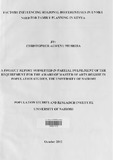| dc.description.abstract | Kenya has been reported to exhibit very significant variations in the uptake of contraceptive methods across the eight provinces. Unmet need for contraception tends to mirror this phenomenon with Nairobi and Central provinces recording the lowest levels of unmet need whereas Rift Valley and Nyanza report the highest levels. Many of the' findings that are published and disseminated tend to focus on the global picture on unmet need for family planning in Kenya as country and quite often the true picture of family planning needs in the country is masked in the regional statistics. This study uses frequency distributions as well as bivariate and multivariate methods (chi-square and logistic regression) to describe the association of the dependent variable of unmet need for family planning with seven covariates (age, level of education, knowledge of contraceptive method, number of living children, place of residence, religion and household wealth). Chi-square tests show that there is a strong association between age and unmet need for family planning across all the provinces.
Coast, Nyanza, Rift Valley and Western provinces show a high level of unmet need at younger ages (15-34). In these four provinces, the highest proportion of this unmet need is for spacing. Nairobi, Central and Eastern Provinces show a high level of un met need at older ages (35-49). In these three provinces the greater proportion of these are clustered as having unmet need for limiting births. Chi square test for level of education and unmet need show a strong association between married women who have attained primary school education and unmet need. Nairobi and North Eastern provinces have a greater proportion of married women with unmet need with secondary education and no education respectively. It is important to note that the greater proportion of the unmet need felt in Nairobi, Central, Eastern and Rift valley is for limiting births. In contrast the vast majority of the unmet need felt in Coast Nyanza, Western and North Eastern is for spacing. This is an indicator of the early age at marriage in this cluster of provinces.
Regression analyses reveal that age, number of living, children, level of education and household wealth hold statistical significance in determining unmet need for family planning. The various components of unmet need for contraception namely; spacing, limiting and overall unmet need, varied considerably across the provinces. The regression model for spacing births revealed that married women with primary level education living in Central province were 30 times more likely to experience unmet need to postpone births than their counterparts who had no education. It is recommended that future researchers conduct qualitative studies on this same topic to further enrich the knowledge on the reasons why women who do not wish to continue childbearing or wish to postpone childbearing do not use any form of modem birth control. Qualitative studies for variables that have shown some level of significance including religion need to be explored further. | en_US |

